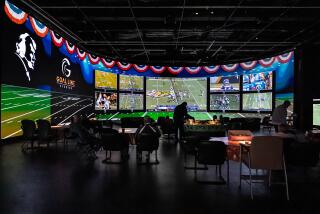In a first, Madden NFL accurately predicts score for Super Bowl XLIX
Less than two weeks ago, a handful of staffers gathered in a room at the EA Sports studios in Orlando, Fla., for an annual glimpse into the future. EA Sports, which makes the popular Madden NFL video game, has held such a meeting for 12 years, since they began using the game to predict the winner of the Super Bowl.
They fired up an Xbox One, hit start and watched a full-length simulation of the game on a screen. It was astonishing. In the Madden NFL 15 game, the New England Patriots defeated the Seattle Seahawks, 28-24, with a dramatic fourth-quarter comeback.
Anthony Stevenson, vice president of marketing for EA Sports, was skeptical.
“The Seahawks are going to blow a 10-point lead in the fourth?” he said to colleagues. “It’s hard to see that happening.” The Seahawks had squandered a double-digit second-half lead just once in 31 games over three seasons.
But that’s exactly what happened when the real Super Bowl was played.
The rally and final score weren’t the only details the simulated game accurately foretold.
It also correctly predicted that Patriots quarterback Tom Brady would throw four touchdown passes and be chosen the game’s most valuable player. And that the game-winning touchdown catch would be made by Julian Edelman. Indeed, the simulation was only 27 yards off Brady’s total in passing yardage, and three yards off Edelman’s number in receiving yards.
The video-game maker has correctly predicted the winner in nine of the last 12 Super Bowls, but never before had been this accurate. Hundreds of staffers had analyzed hundreds of game films, charted thousands of plays and wrote millions of lines of code, and the result was uncanny.
About the only key component the simulation didn’t have was the interception made by Malcolm Butler, a rookie free agent out of West Alabama, that sealed the game for the Patriots.
John Madden, the former football coach and broadcaster who helped launch the game in 1988, envisioned it eventually being so accurate that it could be used as a tool for coaches and players.
“A computer,” Madden said in a phone interview Monday, “is a helluva lot smarter than me.”
The game has grown so sophisticated that it operates similarly to an NFL team, with analysts who break down film and adjust player attributes to match real life.
“The NFL literally calls us the 33rd franchise,” Stevenson said.
Donny Moore, whose official title is Ratings Guru, reviews film of each game, along with film of practices, preseason games and even the college games of players new to the league.
He assigns ratings to each NFL player in more than 60 categories, from traditional ones such as speed and throwing power to intangibles such as clutch performance.
One satirical letter, written from the point of view of Ethan Albright, the worst-rated player in the 2007 version of the video game, mocked the ratings as contrived.
“I have received the impression that you feel that I am lacking in the agility category,” read the letter, which was widely circulated. “I should consider a walk through my living room where I don’t crash through a wall or kick over furniture a resounding success. My agility rating on your game [out of 100] is 33.”
But the ratings carry prestige around the league. Players have called Moore to lobby for better marks.
Other EA Sports staffers create playbooks for each NFL team — each 300 plays based on the preferences of the head coach and coordinator. For example, in the Super Bowl simulation, if the Seahawks had the ball near the goal line to end the game, the computer, based on data, would have decided whether it would have been best to pass or hand the ball off to Marshawn Lynch.
Recently, programmers have begun accounting for factors that are harder to measure, like personalities and team chemistry.
Before the simulation, programmers accounted for injuries and roster changes. Then they let the game play out, the 22 players all reacting to the others’ actions and tendencies.
“It’s kind of like a virtual chess match,” Stevenson said.
Other predictive models use as many as 10,000 separate simulations for a single game. EA Sports uses one.
“I’m sure if you wanted to call up Russell Wilson right now and Pete Carroll and ask them if they’d like to run it again, I’m sure they’d tell you, yeah,” Stevenson said, referring to the Seahawks quarterback and coach. “But that’s not reality, right?”
It also makes the simulation more marketable, provided the prediction is correct. The game has predicted the margin of victory in the past, but until this year not the precise score. Soon after the game, ESPN began touting the video game’s prognostication.
“They can milk it like crazy when the new edition comes out,” said Miro Copic, a professor of branding at San Diego State’s College of Business.
Copic said the prediction, and the notoriety it has generated, could lead to a small bump in sales in the short term. But it could have larger implications if fans start using the video game for other predictive purposes, like fantasy football.
In Las Vegas, Madden has yet to catch on as a secret weapon for gamblers or sports book executives who set the betting lines.
“I don’t pay any attention to that,” said Jay Rood, the sports book director for MGM Resorts.
Rood said he hasn’t heard of any gamblers or sports books that use Madden simulations before placing bets.
That’s a relief for Madden, the game’s namesake.
“I don’t want anyone to put it on that, to take that information and then go lose their house on it or something,” Madden said. “It’s for entertainment purposes only.”
Follow Zach Helfand on Twitter @zhelfand
Times staff writer Sam Farmer contributed to this report.
More to Read
Go beyond the scoreboard
Get the latest on L.A.'s teams in the daily Sports Report newsletter.
You may occasionally receive promotional content from the Los Angeles Times.











